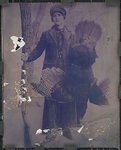 Narrowsburg
NarrowsburgLight Rain Fog/Mist, 43°
Wind: 8.1 mph
 Narrowsburg
NarrowsburgHONESDALE, PA — In the original photograph, Dora Miller looks proud of the large bird she’s holding in her left hand, as she props herself up with a rifle in her right. Only, it’s …
Stay informed about your community and support local independent journalism.
Subscribe to The River Reporter today. click here
This item is available in full to subscribers.
Please log in to continue |


HONESDALE, PA — In the original photograph, Dora Miller looks proud of the large bird she’s holding in her left hand, as she props herself up with a rifle in her right.
Only, it’s hard to see exactly what kind of bird—a turkey, a pheasant?—she’s bagged amidst all the discoloration and broken glass stuck to the photo. Its left wing is fading into obscurity. You can hardly appreciate the fact that the 1920 huntress appears to be casually wearing a full-length cotton dress on the hunt.

“When a photographer took that picture, they didn’t want it to be seen like that,” Chip Forelli said, with his laptop open at Scarfallato’s Diner on a Monday morning. He had a number of other restoration jobs pulled up on the screen: a World War I soldier standing in the middle of a road, flooded with water stains; a man riding a camel across the desert, framed by old pieces of tape; a portrait of a woman whose smile has been ripped through the center.
Forelli, a photographer who moved to Pennsylvania from Manhattan in 2003, has taken up photo restoration to bring these photos back to life. Many of them, saved by family members for decades — in boxes in damp basements, or hanging in frames left to fade in the sun — have been badly damaged. Some, like the photo of Dora Miller, come to Forelli with fragments of glass still stuck to them.
Forelli takes commissions from families who want to restore cherished photos. He has also started working on bigger projects, including restoring photos for the Long Island Collection historical society.
People tend to make the same mistakes handling their photos, Forelli said. To begin with, if the photo wasn’t properly “fixed” in a darkroom—the final stage of the developing process that makes a photo last—it won’t hold up for 100 years. Then people use acidic tape or mat to mount the photos, and the acid eats away at the print; they hang them in the sunlight without UV-filtering glass, or they store them in albums or boxes in damp places.
In his first restoration, bride and groom Franz Kerzie and Francisca Kepic pose for a portrait on their wedding day, discolored and surrounded by rips and tears that threaten to consume the whole portrait. Caroll Curran brought the photo of her grandparents to Forelli because she was afraid to show it to her mother, who is suffering from dementia. Kerzie died in a mine explosion, so the disfigured image, in which Kerzie’s right shoulder is torn away entirely, would have been particularly upsetting, Curran worried.

“You can’t restore something that isn’t there,” Forelli said of the challenge in making the groom whole again. He Dr. Frankenstein’d the image, using Photoshop to clone a similar-looking shoulder from another photo he had in his stock that he then fit to the groom’s body.
“Photographic surgery,” Forelli said with a smirk.
Curran was teary-eyed when she received the restored version of her great-grandparents. “The reaction is often very emotional and very satisfying to me as a photographic technician and a family man,” Forelli said.
Restoration work of this kind suggests that modern technology doesn’t necessarily mean the end of film. Rather, it’s a useful tool in making the old new again. Forelli, who still shoots with film for his personal work, has accepted the prevalence of new technology. He still processes film in a darkroom, but uses an inkjet archival printer rather than an enlarger.
Forelli also teaches workshops in which he encourages people to use their iPhones to shoot if it’s the only camera they have.
“The whole business of photography has changed on all levels,” he said. “It’s a real hybrid approach. But it works for me.”
Forelli's work will be on display at the Wine Room, 1202 Main St., Honesdale in this year’s Wayne County Arts Alliance’s Art Tour July 12, 13 and 14. He will provide scanning services during the tour as well, for film, transparencies, or prints (up to 8.5” x 11”).
Contact Forelli at 570/224-0873 | photo@chipforelli.com | www.chipforelli.com.
Comments
No comments on this item Please log in to comment by clicking here